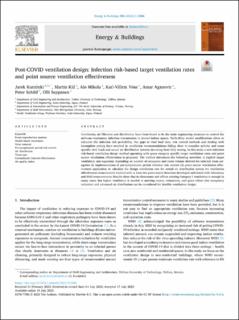| dc.contributor.author | Kurnitski, Jarek | |
| dc.contributor.author | Kiil, Martin | |
| dc.contributor.author | Mikola, Alo | |
| dc.contributor.author | Võsa, Karl-Villem | |
| dc.contributor.author | Aganovic, Amar | |
| dc.contributor.author | Schild, Peter G. | |
| dc.contributor.author | Seppänen, Olli | |
| dc.date.accessioned | 2023-11-22T07:45:47Z | |
| dc.date.available | 2023-11-22T07:45:47Z | |
| dc.date.created | 2023-10-02T12:26:20Z | |
| dc.date.issued | 2023 | |
| dc.identifier.citation | Energy and Buildings. 2023, 296 . | en_US |
| dc.identifier.issn | 0378-7788 | |
| dc.identifier.uri | https://hdl.handle.net/11250/3103977 | |
| dc.description.abstract | Ventilation, air filtration and disinfection have been found to be the main engineering measures to control the airborne respiratory infection transmission in shared indoor spaces. Wells-Riley model modifications allow to calculate the infection risk probability, but gaps in viral load data, risk control methods and dealing with incomplete mixing have resulted in ventilation recommendations falling short to consider activity and room specific viral loads and actual air distribution systems deviating from fully mixing. In this study a new infection risk-based ventilation design method operating with space category specific target ventilation rates and point source ventilation effectiveness is proposed. The method introduces the following novelties: i) explicit target ventilation rate equations depending on number of occupants and room volume derived for selected room categories ii) implementation of pre-symptomatic period infection risk control iii) point source ventilation effectiveness application to calculate the design ventilation rate for actual air distribution system iv) ventilation effectiveness measurement method with at least two point source locations developed and tested with laboratory and field measurements. Results show that in classrooms and offices existing Category I ventilation is enough in many cases, but higher ventilation is needed in meeting rooms, restaurants, and gyms where also occupancy reduction and advanced air distribution can be considered for feasible ventilation design. | en_US |
| dc.language.iso | eng | en_US |
| dc.rights | Navngivelse 4.0 Internasjonal | * |
| dc.rights.uri | http://creativecommons.org/licenses/by/4.0/deed.no | * |
| dc.title | Post-COVID ventilation design: Infection risk-based target ventilation rates and point source ventilation effectiveness | en_US |
| dc.type | Peer reviewed | en_US |
| dc.type | Journal article | en_US |
| dc.description.version | publishedVersion | en_US |
| cristin.ispublished | true | |
| cristin.fulltext | original | |
| cristin.qualitycode | 2 | |
| dc.identifier.doi | 10.1016/j.enbuild.2023.113386 | |
| dc.identifier.cristin | 2180904 | |
| dc.source.journal | Energy and Buildings | en_US |
| dc.source.volume | 296 | en_US |
| dc.source.pagenumber | 13 | en_US |

